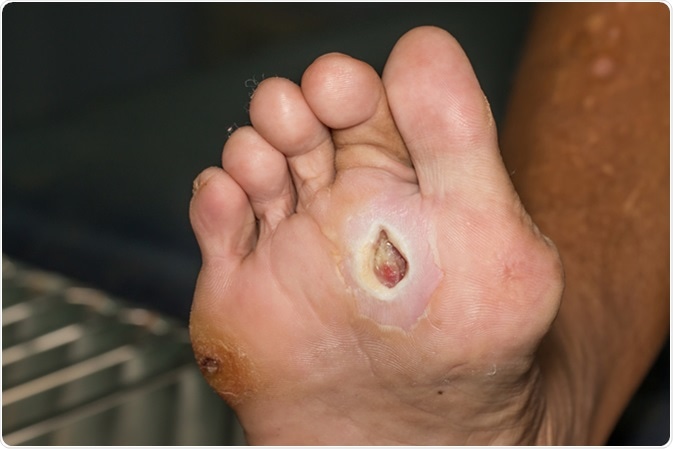What is Diabetes?
Diabetes is characterized by high blood sugar levels. It is associated with many health complications including the improper function of all stages of wound healing. This results in poor wound healing and in severe cases can lead to limb amputations.
Diabetes Development and Symptoms
Diabetes mellitus (DM) is characterized by high blood sugar levels over a prolonged period. There are three main types of diabetes:
- Type 1 DM resulting from the failure of the pancreas to produce enough insulin
- Type 2 DM begins with insulin resistance which then progresses to a lack of insulin
- Gestational diabetes which occurs when pregnant women without a previous diabetes history develop high blood sugar levels
Symptoms of diabetes include weight loss, increased urination, increased thirst, and increased hunger. Type 1 normally develops quite quickly, whereas type 2 develops more gradually.
Treatment of Diabetes
Diabetes can be managed by keeping blood sugar levels as close to normal as possible. Some measures to achieve this are maintaining normal body weight, engaging in regular exercise, and having a healthy diet. These lifestyle changes may even prevent the development of type 2 diabetes.
As well as lifestyle changes, medications may be used to treat diabetes. Anti-diabetic medication can reduce blood sugar levels. Angiotensin-converting enzyme inhibitors (ACEIs) can lower blood pressure. Individuals with obesity and type 2 diabetes can benefit from weight loss surgery.
Complications of Diabetes
Diabetes can result in several health complications, many of which may take several years to develop. A major complication of diabetes is damage to blood vessels resulting from high blood pressure. In this way, diabetes doubles the risk of cardiovascular disease and strokes. Diabetes also causes damage to the small blood vessels supplying the eyes, kidneys, and nerves.
I’m the offense, you’re the defense: Diabetes and wound healing
How Does a Wound Heal?
The healing of a wound is very complex. It involves the actions of many cell types at the site of the wound as well as cells that migrate to the site of the wound. Healing of a wound occurs in 4 phases:

Wound of diabetic foot. Image Credit: ittipon / Shutterstock
Blood Clotting
This step occurs very quickly following an injury. Platelets in the blood begin to stick to the sire of injury. The platelets are activated and become amorphous, this being more suitable to clotting; they also release chemicals that promote clotting. The plasma protein fibrinogen is activated as a result to form fibrin, a stringy protein; the fibrin forms a mesh to trap the platelets and other cells in blood. A clot is now formed.
Inflammation
This step involves clearing out the damaged and dead cells, as well as pathogens such as bacteria. This is done by certain white blood cells via phagocytosis. Platelet-derived growth factors are also released into the wound causing the migration and division of cells in the next step.
Tissue Growth
This step starts off with the production of new blood vessels (angiogenesis). Collagen is also deposited at the site of the wound, granulation tissues is formed and the new extracellular matrix is grown. Epithelialization creates more epithelial cells in the dermis and they migrate to the epidermis. Finally, the wound contracts to begin closing the gap between the edges.
Tissue Remodeling
During this last step, collagen is realigned along tension lines and cells that are no longer needed are removed via apoptosis.
The Effect Diabetes Has on Wound Healing
As mentioned above, angiogenesis is key for the healing of wounds. Diabetes leads to a decrease in angiogenesis, delaying wound closure which can lead to a common occurrence, namely, non-healing wounds. Diabetes also alters the ability of macrophages to switch from a pro-inflammatory phenotype to a pro-reparative phenotype, which increases the inflammatory profile in diabetic wounds. The expression of angiogenesis-related mRNA and vascular endothelial growth factor (VEGF) is greatly decreased in diabetic wounds, further decreasing the amount of angiogenesis that occurs.
Platelet-derived growth factor (PDGF) encourages capillary maturation. The levels of PDGF are also decreased in diabetic wounds. A diabetic state also leads to a decreased population of endothelial progenitor cells from the bone marrow. This will decrease the vasculature in diabetic tissues and affects wound healing.
Disruption of Angiogenesis as a Key Contributor to Delay in Wound Healing
The process of wound healing is very complex and takes many steps. Angiogenesis is a key contributor to the healing of a wound. Diabetes disrupts wound healing in many ways but the effect it has on angiogenesis is a major contributor to the delayed wound healing seen in diabetic patients.
Understanding more about diabetes and how it affects processes involved in wound healing will allow for better treatments of diabetic patients with wounds in the future.
Further Reading
Last Updated: Oct 10, 2018